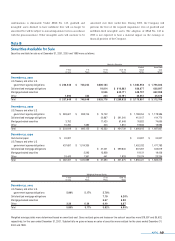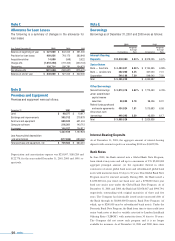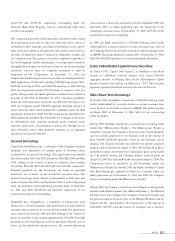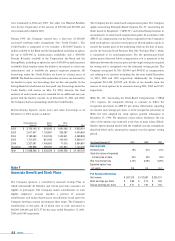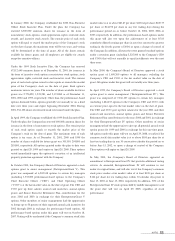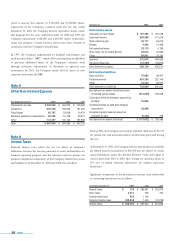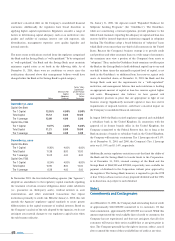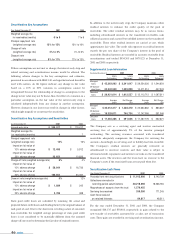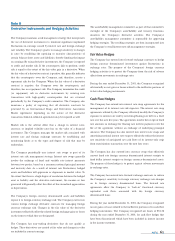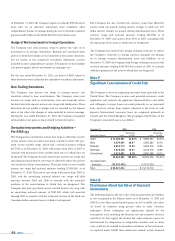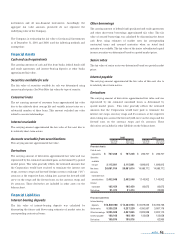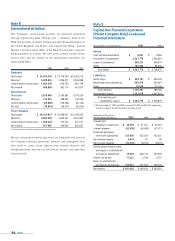Capital One 2001 Annual Report Download - page 61
Download and view the complete annual report
Please find page 61 of the 2001 Capital One annual report below. You can navigate through the pages in the report by either clicking on the pages listed below, or by using the keyword search tool below to find specific information within the annual report.
Certain premises and equipment are leased under agreements that
expire at various dates through 2011, without taking into
consideration available renewal options. Many of these leases provide
for payment by the lessee of property taxes, insurance premiums, cost
of maintenance and other costs. In some cases, rentals are subject to
increase in relation to a cost of living index. Total expenses amounted
to $64,745, $66,108, and $37,685 for the years ended December 31,
2001, 2000 and 1999, respectively.
Future minimum rental commitments as of December 31, 2001, for all
non-cancelable operating leases with initial or remaining terms of one
year or more are as follows:
The Company has entered into synthetic lease transactions to finance
several facilities. A synthetic lease structure typically involves establishing a
special purpose vehicle (“SPV”) that owns the properties to be leased. The
SPV is funded and its equity is held by outside investors, and as a result,
neither the debt of nor the properties owned by the SPV are included in
the Consolidated Financial Statements. These transactions, as described
below, are accounted for as operating leases in accordance with SFAS No.
13,“Accounting for Leases.”
In December 2000, the Company entered into a 10-year agreement for the
lease of a headquarters building being constructed in McLean, Virginia.
Monthly rent commences upon completion, which is expected in
December 2002, and is based on LIBOR rates applied to the cost of the
buildings funded. If, at the end of the lease term, the Company does not
purchase the property, the Company guarantees a residual value of up to
approximately 72% of the estimated $159,500 cost of the buildings in the
lease agreement. Upon a sale of the property at the end of the lease term,
the Company’s obligation is limited to any amount by which the
guaranteed residual value exceeds the selling price.
In 1999, the Company entered into two three-year agreements for the
construction and subsequent lease of four facilities located in Tampa,
Florida and Federal Way, Washington. At December 31, 2001, the
construction of all four of the facilities had been completed. The total cost
of the buildings was approximately $98,800. Monthly rent commenced
upon completion of each of the buildings and is based on LIBOR rates
applied to the cost of the facilities funded. The Company has a one-year
renewal option under the terms of the leases. If, at the end of the lease
term, the Company does not purchase all of the properties, the Company
guarantees a residual value to the lessor of up to approximately 85% of the
cost of the buildings in the lease agreement. Upon a sale of the property at
the end of the lease term, the Company’s obligation is limited to any
amount by which the guaranteed residual value exceeds the selling price.
In 1998, the Company entered into a five-year lease of five facilities in
Tampa, Florida and Richmond, Virginia. Monthly rent on the facilities is
based on a fixed interest rate of 6.87% per annum applied to the cost of
the buildings included in the lease of $86,800. The Company has two one-
year renewal options under the terms of the lease. If, at the end of the lease
term, the Company does not purchase all of the properties, the Company
guarantees a residual value to the lessor of up to approximately 84% of the
costs of the buildings. Upon a sale of the property at the end of the lease
term, the Company’s obligation is limited to any amount by which the
guaranteed residual value exceeds the selling price.
The Company is commonly subject to various pending and threatened
legal actions arising from the conduct of its normal business activities. In
the opinion of management, the ultimate aggregate liability, if any, arising
out of any pending or threatened action will not have a material adverse
effect on the consolidated financial condition of the Company. At the
present time, however, management is not in a position to determine
whether the resolution of pending or threatened litigation will have a
material effect on the Company’s results of operations in any future
reporting period.
Note M
Related Party Transactions
In the ordinary course of business, executive officers and directors of
the Company may have consumer loans issued by the Company.
Pursuant to the Company’s policy, such loans are issued on the same
terms as those prevailing at the time for comparable loans to unrelated
persons and do not involve more than the normal risk of collectibility.
Note N
Off-Balance Sheet Securitizations
Off-balance sheet securitizations involve the transfer of pools of
consumer loan receivables by the Company to one or more third-
party trusts or qualified special purpose entities that are accounted for
as sales in accordance with SFAS 140. Certain undivided interests in
the pool of consumer loan receivables are sold to investors as asset-
backed securities in public underwritten offerings or private
placement transactions. The remaining undivided interests retained
by the Company (“seller's interest”) are recorded in consumer loans.
The amounts of the remaining undivided interests fluctuate as the
accountholders make principal payments and incur new charges on
the selected accounts. The amount of seller's interest was $5,675,078
and $3,270,839 as of December 31, 2001 and 2000, respectively.
The key assumptions used in determining the fair value of the
interest-only strip resulting from securitizations of consumer loan
receivables completed during the period included the weighted
average ranges for charge-off rates, principal repayment rates, lives of
receivables and discount rates included in the following table.
notes 59
2002 $ 57,619
2003 51,667
2004 36,082
2005 30,366
2006 21,583
Thereafter 56,254
Total $ 253,571


